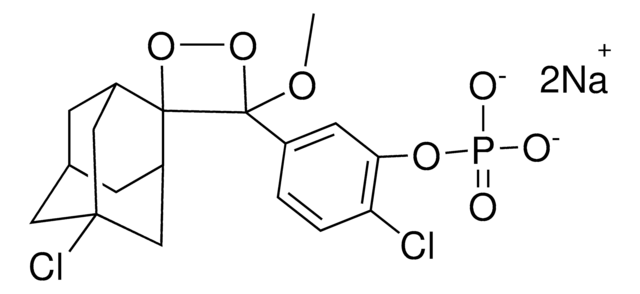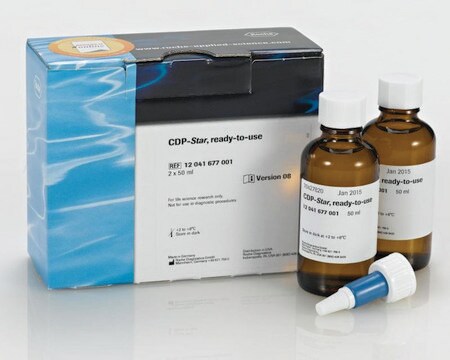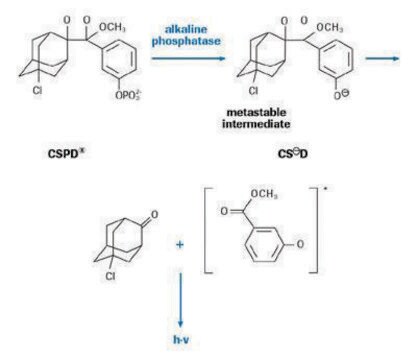CDP-RO
Roche
CDP-Star®
Disodium 2-chloro-5-(4-methoxyspiro {1,2-dioxetane-3,2′-(5′-chloro)tricyclo[3.3.1.13,7 ]decan}-4-yl)-1-phenyl phosphate
Sinônimo(s):
CDP-Star® Chemiluminescent Substrate, ready-to-use, cdp-star, Disodium 2-chloro-5-(4-methoxyspiro[1,2-dioxetane-3,2′-(5-chlorotricyclo[3.3.1.13.7]decan])-4-yl]-1-phenyl phosphate
About This Item
Produtos recomendados
Nível de qualidade
Ensaio
>98%
forma
solution
embalagem
bottle of 1 mL (11685627001[25 mM])
bottle of 2 × 1 mL (11759051001[25 mM])
fabricante/nome comercial
Roche
Condições de expedição
wet ice
temperatura de armazenamento
2-8°C
cadeia de caracteres SMILES
Cl[C@]1(C2)C[C@H]3C4(OOC4(C5=CC(OP([O-])([O-])=O)=C(Cl)C=C5)OC)[C@@H]2C[C@@H](C1)C3
InChI
1S/C18H21Cl2O7P.2Na/c1-24-18(14-6-13(2-3-15(14)19)25-28(21,22)23)17(26-27-18)11-4-10-5-12(17)9-16(20,7-10)8-11;;/h2-3,6,10-12H,4-5,7-9H2,1H3,(H2,21,22,23);;/q;2*+1/p-2/t10-,11-,12+,16-,17?,18?;;
chave InChI
UKWLRLAKGMZXJC-VCCHNUGISA-L
Procurando produtos similares? Visita Guia de comparação de produtos
Descrição geral
25 mM solution (12.38 mg/ml), 100x concentration
Aplicação
- Southern blot
- Northern blot
- Dot blot
- Colony and plaque hybridization
- Gel shift assays
Características e benefícios
- Save time with a fast, ultra-sensitive substrate.
- Easily strip and reprobe membranes.
- Take multiple exposures of up to two days for each experiment.
- Reuse the substrate by filtering and storing in sodium azide.
Qualidade
Nota de preparo
Maleic Acid Buffer: 15 to 25 °C, stable
Detection Buffer: 15 to 25 °C, stable
Blocking Solution: always prepare freshly
Antibody Solution: 2 to 8 °C
Outras notas
- First exposure to X-ray film should be 5-15 minutes. Examine film and then determine other exposure times based on initial result.
- No preincubation step required.
- Apply substrate quickly to avoid gray shadows from substrate drops and drying of membrane (leads to uneven, high background).
- Do not use plastic wrap to cover blot; use hybridization bags, acetate sheet protectors, or two sheets of transparent film.
- Exposure times are shorter than with CSPD.
- Do not use nitrocellulose membranes.
- Repeat exposures can be made up to two days after the addition of substrate.
Informações legais
produto relacionado
Código de classe de armazenamento
12 - Non Combustible Liquids
Classe de risco de água (WGK)
nwg
Ponto de fulgor (°F)
No data available
Ponto de fulgor (°C)
No data available
Certificados de análise (COA)
Busque Certificados de análise (COA) digitando o Número do Lote do produto. Os números de lote e remessa podem ser encontrados no rótulo de um produto após a palavra “Lot” ou “Batch”.
Já possui este produto?
Encontre a documentação dos produtos que você adquiriu recentemente na biblioteca de documentos.
Os clientes também visualizaram
Nossa equipe de cientistas tem experiência em todas as áreas de pesquisa, incluindo Life Sciences, ciência de materiais, síntese química, cromatografia, química analítica e muitas outras.
Entre em contato com a assistência técnica


![CSPD ready-to-use Disodium 3-(4-methoxyspiro {1,2-dioxetane-3,2′-(5′-chloro)tricyclo [3.3.1.13,7]decan}-4-yl)phenyl phosphate](/deepweb/assets/sigmaaldrich/product/images/352/091/ef743cea-ccd8-44f1-8f3b-dec5a1e4f5d1/640/ef743cea-ccd8-44f1-8f3b-dec5a1e4f5d1.jpg)







